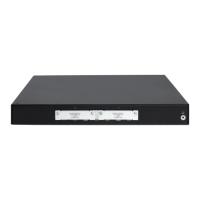99
Item Description
Entity Name
Select the local PKI entity.
When submitting a certificate request to a CA, an entity needs to show its identity
information.
Available PKI entities are those that have been configured.
Institution
Select the authority for certificate request.
• CA—Entity requests a certificate from a CA.
• RA—Entity requests a certificate from an RA.
Generally, an independent RA is in charge of certificate request management. It
receives the registration request from an entity, examines its qualification, and
determines whether to ask the CA to sign a digital certificate. The RA only examines
the application qualification of an entity. It does not issue any certificate. Sometimes,
the registration management function is provided by the CA, in which case no
independent RA is required. Hewlett Packard Enterprise recommends that you deploy
an independent RA.
Requesting URL
Enter the URL of the RA.
The entity will submit the certificate request to the server at this URL through the
SCEP protocol. The SCEP protocol is intended for communication between an entity
and an authentication authority.
In offline mode, this item is optional. In other modes, this item is required.
IMPORTANT:
• In offline mode, this item is optional. In other modes, this item is required.
• This item does not support domain name resolution.
LDAP IP
Enter the IP address, port number, and version of the LDAP server.
An LDAP server is usually deployed to store certificates and CRLs. If this is the case,
you must configure the IP address of the LDAP server..
Port
Version
Request Mode
Select the online certificate request mode, which can be auto or manual.
Password
Set a password for certificate revocation and re-enter it for confirmation.
The two boxes are available only when the certificate request mode is set to
Auto
.
.
Confirm Password
Fingerprint Hash
Specify the fingerprint used for verifying the CA root certificate.
After receiving the root certificate of the CA, an entity needs to verify the fingerprint of
the root certificate, namely, the hash value of the root certificate content. This hash
value is unique to every certificate. If the fingerprint of the root certificate does not
match the one configured for the PKI domain, the entity will reject the root certificate.
• If you specify MD5 as the hash algorithm, enter an MD5 fingerprint. The
fingerprint must a string of 32 characters in hexadecimal notation.
• If you specify SHA1 as the hash algorithm, enter an SHA1 fingerprint. The
fingerprint must a string of 40 characters in hexadecimal notation.
• If you do not specify the fingerprint hash, do not enter any fingerprint. The entity
will not verify the CA root certificate, and you yourself must make sure the CA
server is trusted.
IMPORTANT:
The fingerprint must be configured if you specify the certificate request mode as Auto.
If you specify the certificate request mode as Manual, you can leave the fingerprint
settings null. If you do not configure the fingerprint, the entity will not verify the CA root
certificate and you yourself must make sure the CA server is trusted.
Fingerprint
Polling Count
Set the polling interval and attempt limit for querying the certificate request status.
After an entity makes a certificate request, the CA might need a long period of time if it

